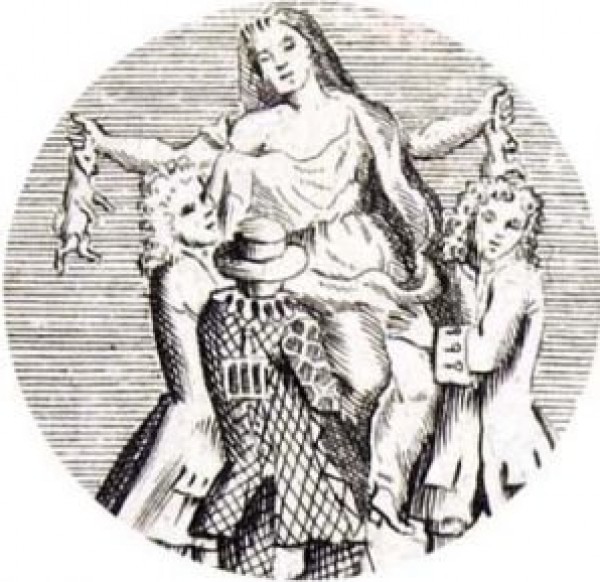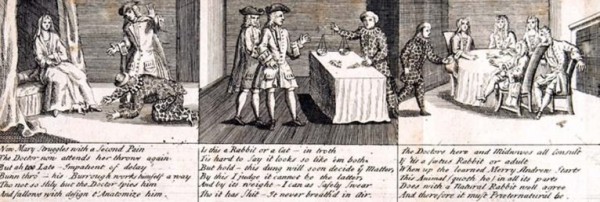 In September 1726, reached the news to the King , "George I" court, for the case of a mysterious and rare birth of her heroine maid of poor living in the "Godalming" village, near Guildford County in Surrey, at the age of 25 years, and married From a clothing vendor with 3 children.
In September 1726, reached the news to the King , "George I" court, for the case of a mysterious and rare birth of her heroine maid of poor living in the "Godalming" village, near Guildford County in Surrey, at the age of 25 years, and married From a clothing vendor with 3 children. She had already miscarried her fourth pregnancy the previous month. Having suffered from labor pains, she had put something like a "heartless cat" in the presence of a number of village women.
The news included the birth certificate of the district doctor, John Howard, who was called to examine Mary, and was surprised to find Mrs. L (rabbit head, cat legs and 9 dead rabbits) in one day; and by a group of the greatest doctors and scholars, England, to inform them of "miraculous birth," the king sent a team to investigate the case to begin the saga that Rotana magazine recounted its details.
 The king sent two men from the royal court to investigate the bizarre news: Nathaniel St. Andre, Swiss surgeon on tatters, and autopsy doctor Samuel Molino, secretary of the Prince of Wales. At that time poor Mary was transformed into a celebrity in the kingdom, From Goodalling village to Guildford County for close surveillance.
The king sent two men from the royal court to investigate the bizarre news: Nathaniel St. Andre, Swiss surgeon on tatters, and autopsy doctor Samuel Molino, secretary of the Prince of Wales. At that time poor Mary was transformed into a celebrity in the kingdom, From Goodalling village to Guildford County for close surveillance.
On November 15, 1726, King André and Molino arrived, and with the help of the obstetrician Howard, the doctors performed tests on the lungs and other internal organs of the small rabbits. The results showed that they probably did not develop into Mary's womb. However, André "is convinced that this birth is a supernatural incident and before returning to London he took samples of rabbits for the king and Prince of Wales.
Mary gives birth to 15 rabbits
Shortly after, the news spread that Mary had put 15 dead rabbits, and with the spread of the story, the king decided to send the German surgeon Siriacus Ahlers to Guildford to investigate.
The young "Ahlers" was examined and many witnessed her birth to the rabbits. However, he was not convinced. He returned to London with other samples of the dead "Mary" rabbits. After examining the results, the results were shocking. One of the rabbits (corn, hay, and straw), proving that these creatures did not develop within Mary's womb.
The Ahlers report on November 21 concluded that there was a trick in this.
Doctor "Andre" and the story "Mary" exotic
 Both Andre and Howard were convinced of the story of Mary. During their follow-up to the case, she sought help from Richard Manningham, a well-known physician in London. After watching and seeing her, he also seemed unconvinced; but Andre was persuaded to keep Complain to himself so as not to be accused of fraud and promotion of something false.
Both Andre and Howard were convinced of the story of Mary. During their follow-up to the case, she sought help from Richard Manningham, a well-known physician in London. After watching and seeing her, he also seemed unconvinced; but Andre was persuaded to keep Complain to himself so as not to be accused of fraud and promotion of something false.
In April, she was working in a field and she was pregnant. When I saw the rabbits, I wanted to eat rabbit meat very much. I ran to catch someone but she could not. That night I dreamed she was eating rabbit meat. When I woke up I felt a strange pain that continued until morning, and pointed out that she had remained for almost three months craving rabbit meat but was poor she could not buy.
"Mary" has a medical problem
After Mary's novel, the medical debate began in December 1726 with what was known as the "maternal impression", a phenomenon that showed congenital defects and disorders in the fetus, as a result of the emotional stimulation experienced by pregnant women (such as Marie's dream and her desire for rabbit meat) What on the fetus.
The talk was also about mental problems such as depression or schizophrenia, a phenomenon that a child may suffer if his mother suffers from it during pregnancy. A woman who has suffered from a great sadness during pregnancy may depress the depressive tendencies of her fetus.
After five months of medical discussions, after the discovery of Mary's trick, James Blundell published his book The Power of Imagination in Pregnant Women, in which he challenged the belief in the pregnant woman's previous influence on the fetus, a medical argument that lasted until the next century, How deceived "Mary" everyone?
"The Poor Girl"
 Between November 30 and December 3, the surveillance was split between the doctors who gathered there, Mary did not put more new rabbits at that time; but she continued to pretend to suffer from the pains of childbirth and had severe seizures that made her lose consciousness.
Between November 30 and December 3, the surveillance was split between the doctors who gathered there, Mary did not put more new rabbits at that time; but she continued to pretend to suffer from the pains of childbirth and had severe seizures that made her lose consciousness.
Shortly afterwards, one of the workers, who tried to sneak into Mary's room with a small rabbit, was arrested. The man confessed to the doctor, James Douglas, that Mary's brother's wife had asked him to buy the smallest rabbit he could find.
The doctor was determined to obtain a confession of guilt from Mary, but she decided not to confess. Douglas contacted Sir Thomas Clarke, the judge, to question her the same night. Mary kept straying for two full days.
After the failure of the judge, the doctor, "Richard Manningham" threatened to "Mary" painful surgical surgery to see if it may differ from other women, was terrified and forced to recognize on the seventh of December 1726, that they introduced rabbits dead hand in her vagina and then allowed As if she were giving birth.
On 9 December, Marie Tuft was charged with "fraud and forgery" and was thrown into the prison of "Bridwell" after damaging the medical profession and all the doctors who took part in her examination or were associated with her case. However, by the following year, the case had disappeared, "Mary" from prison in order not to continue investigations, and to revive the story and the woman died in January 1763.






